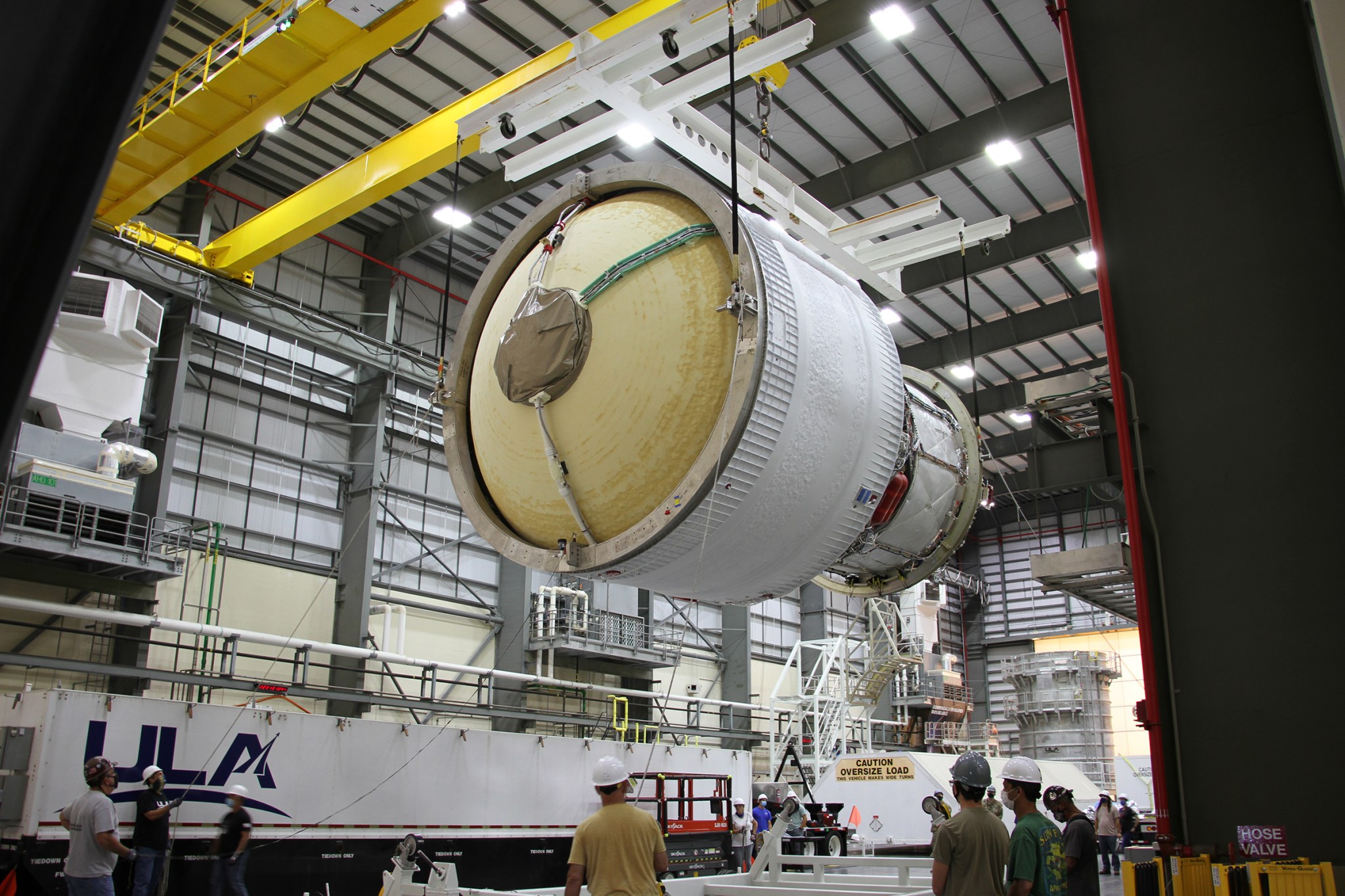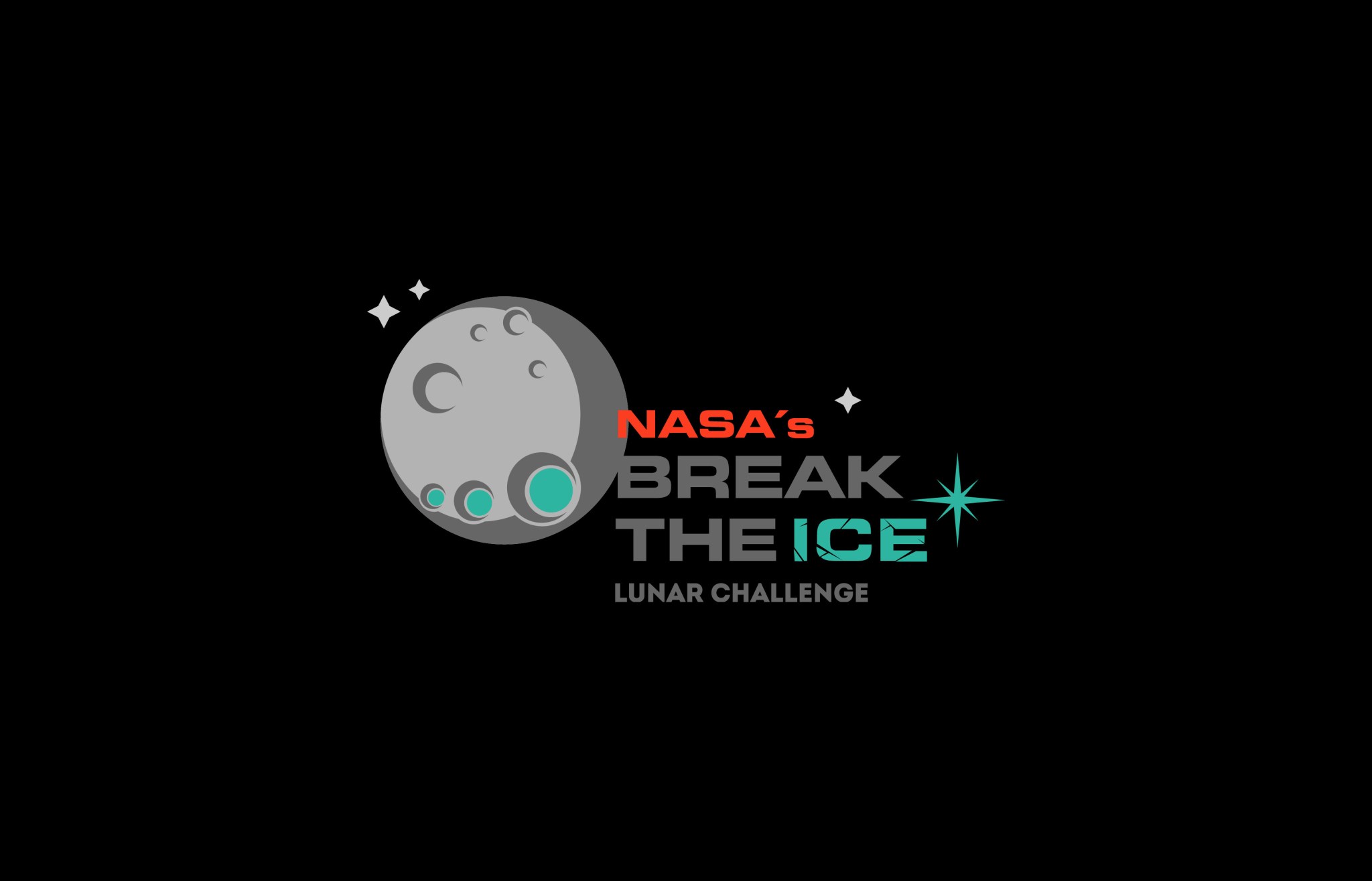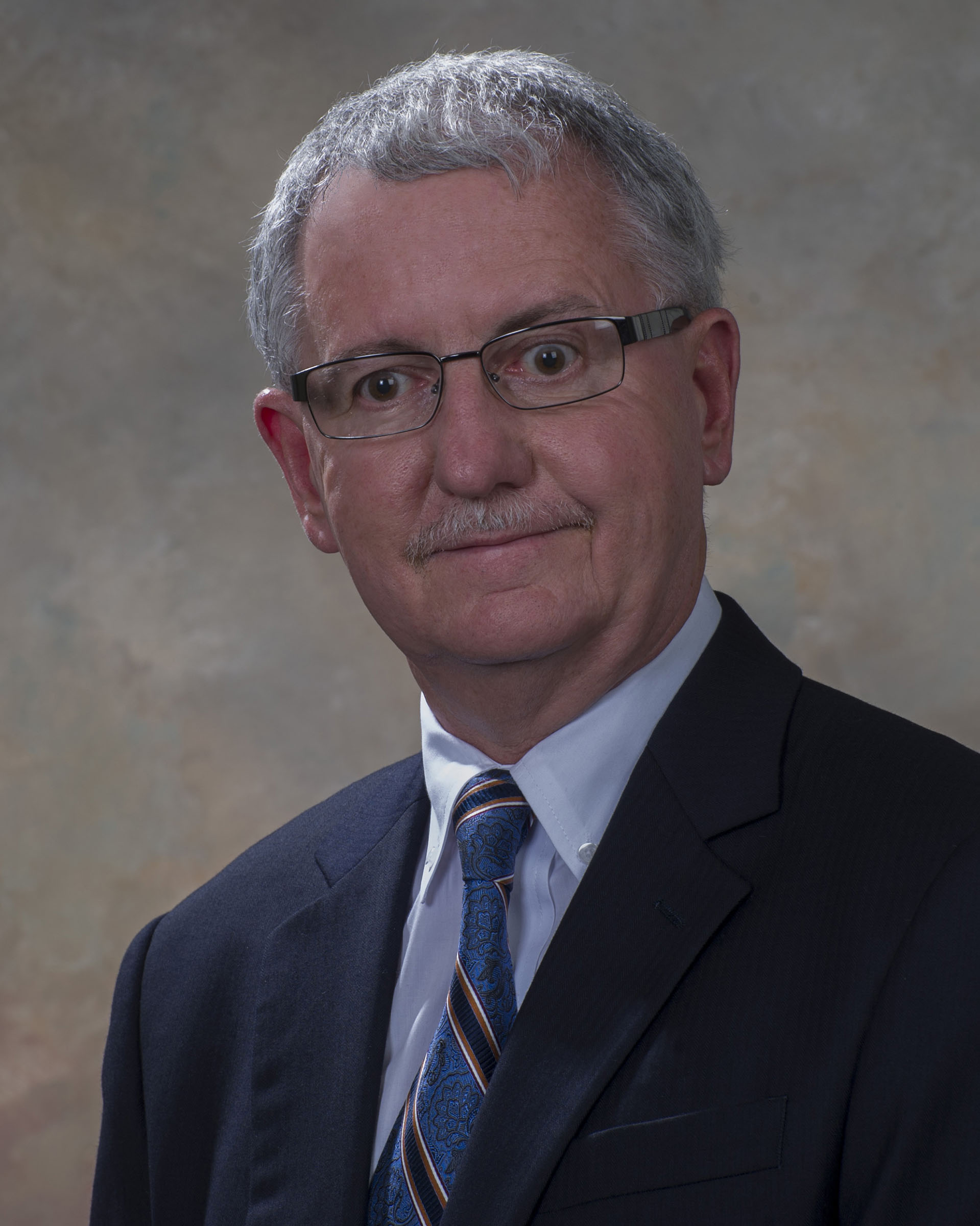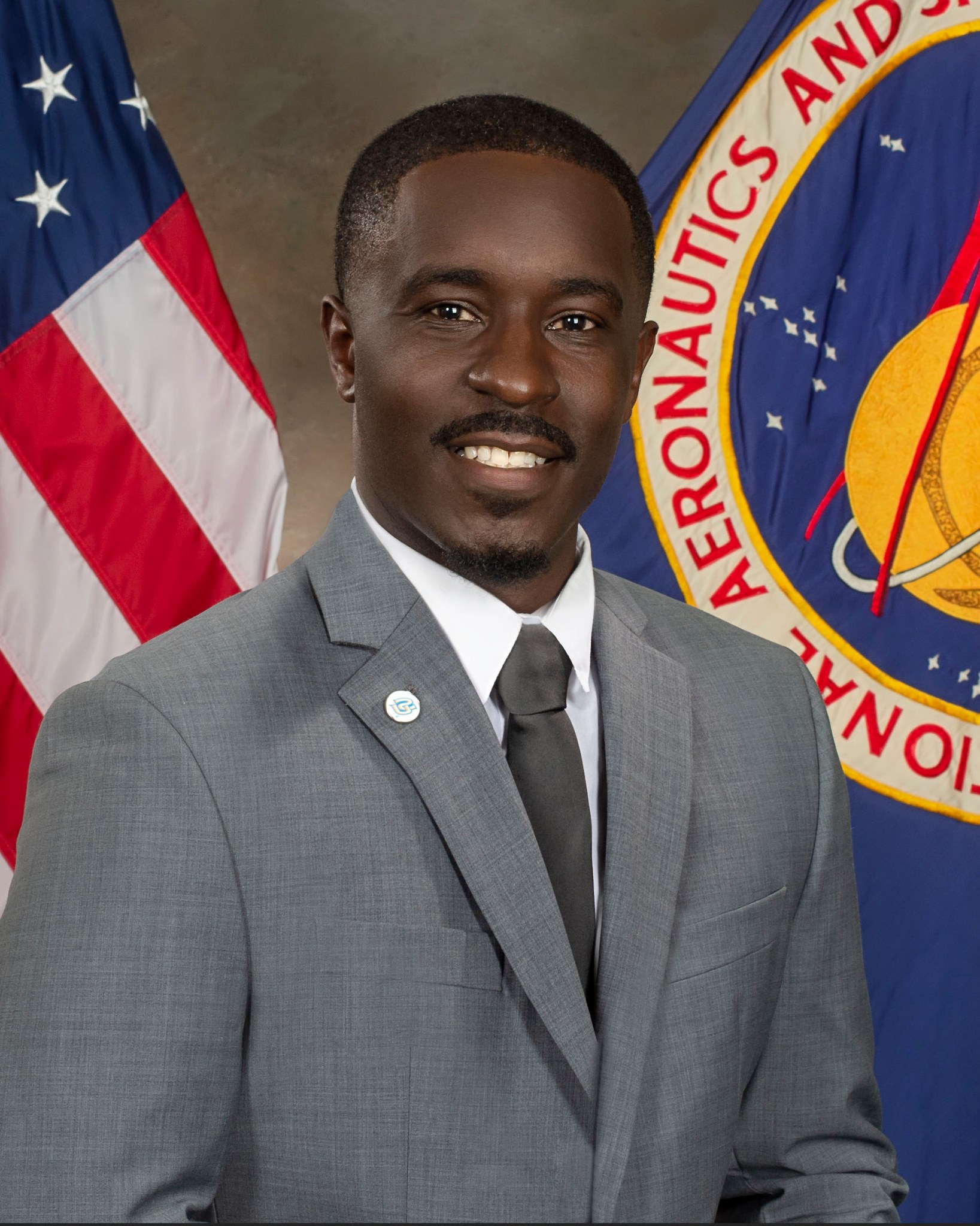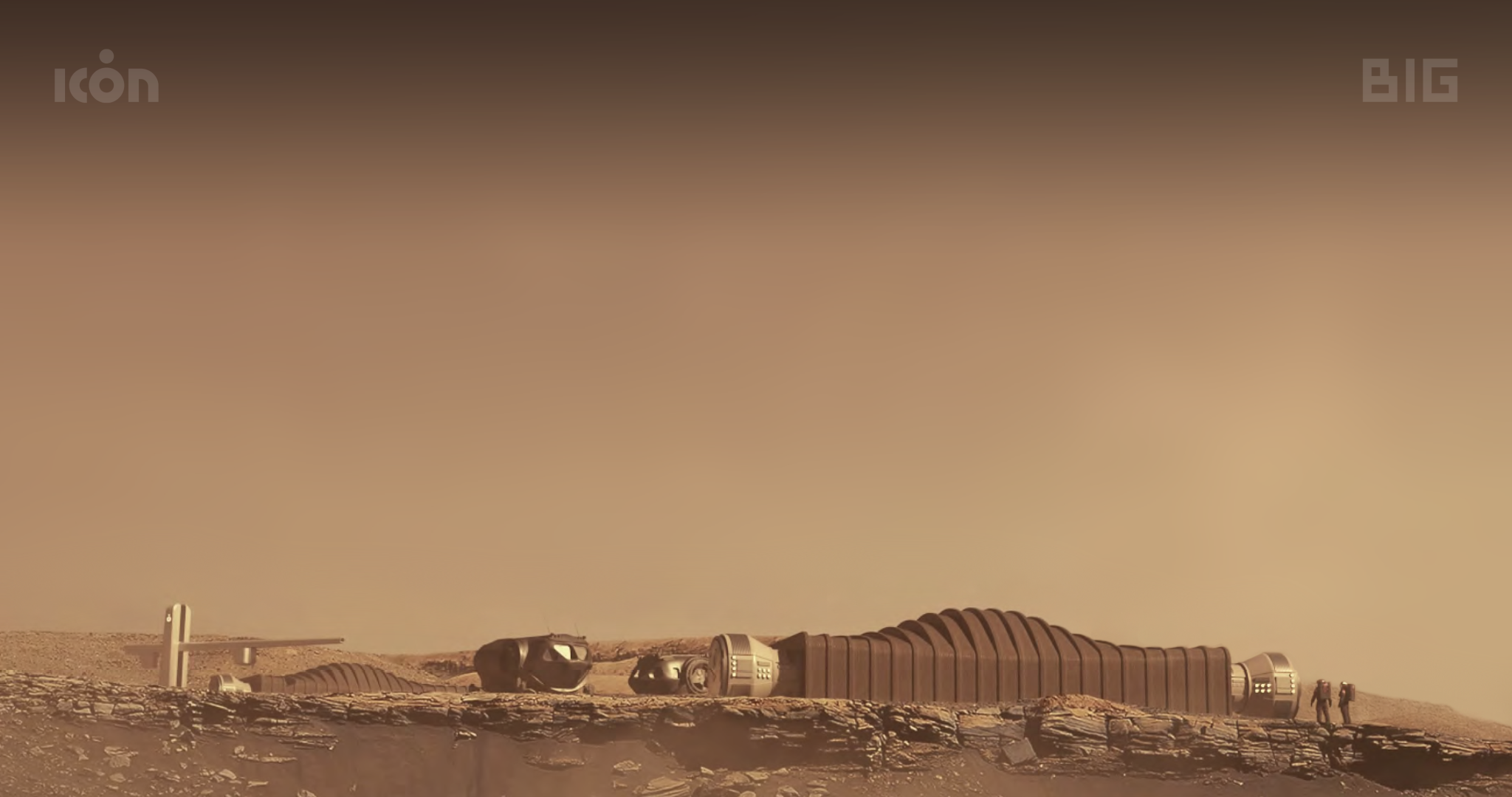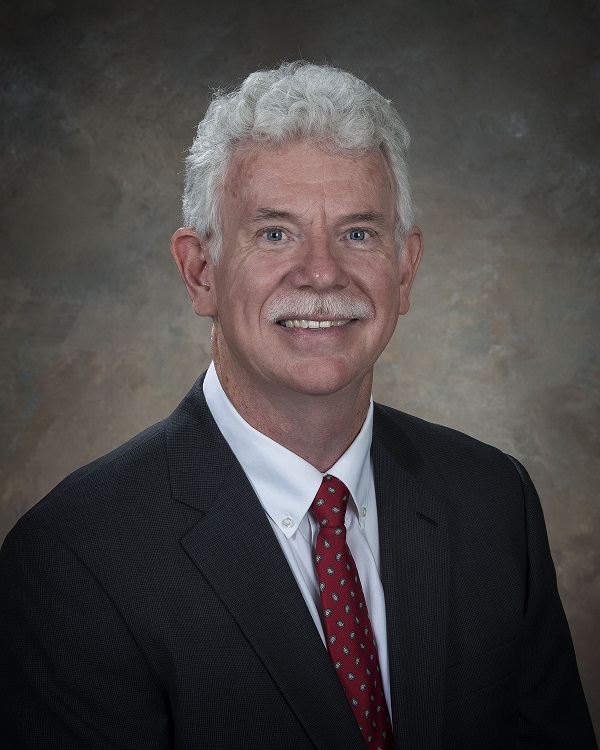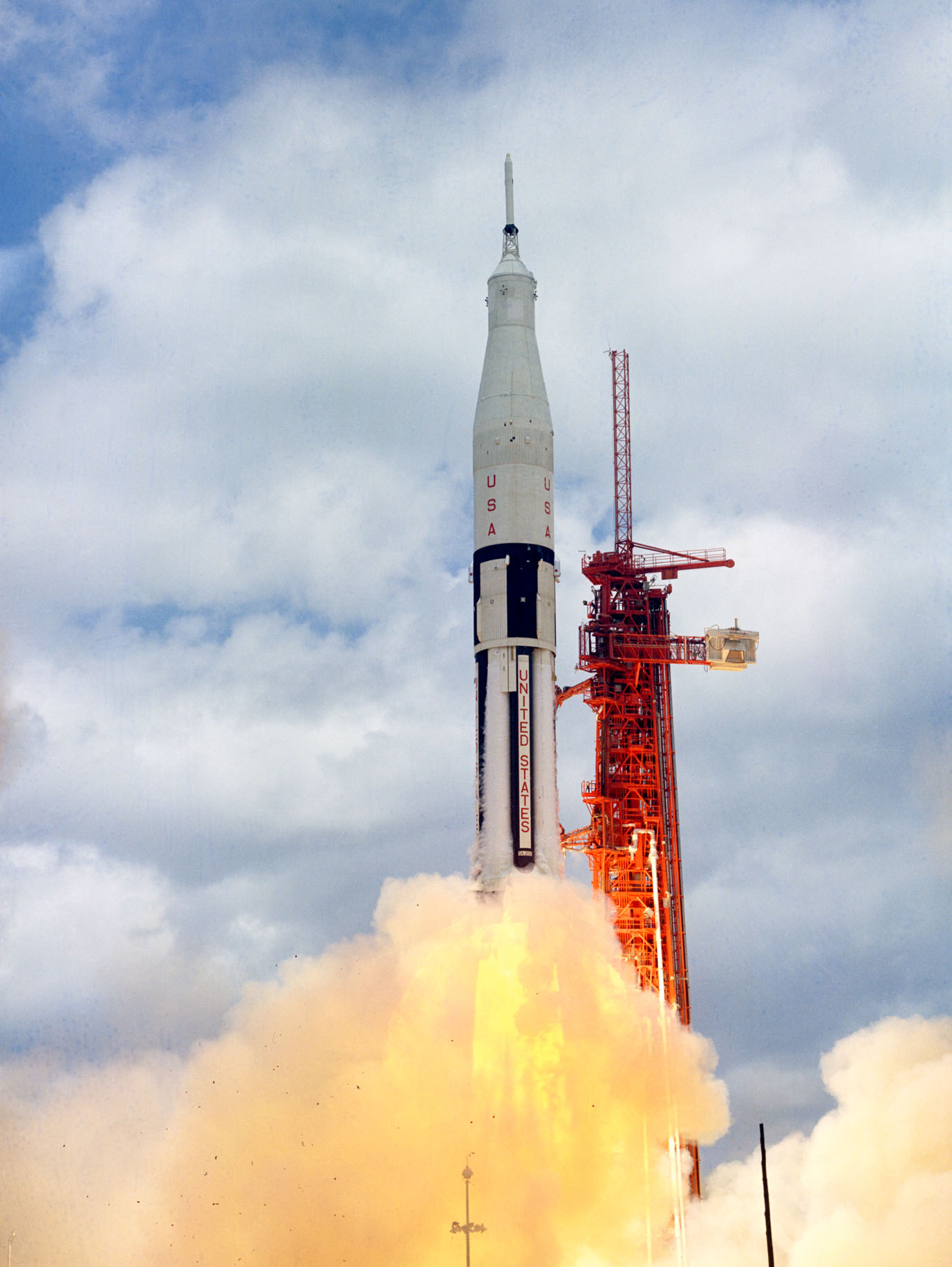Vibration Tests for Moon Rocket Help Ensure Safe Travels on Road to Space
By Will Bryan
NASA will soon conduct SLS and Orion integrated modal testing at the agency’s Kennedy Space Center ahead of the Artemis I mission launch. Teams there will examine the considerable forces and vibrations the recently stacked rocket will incur on its way to space.
To safely control the rocket, flight software and the navigation system must distinguish the rocket’s natural frequencies from the vibration frequencies experienced during flight. SLS Chief Engineer Dr. John Blevins knows just how important these tests will be for success.
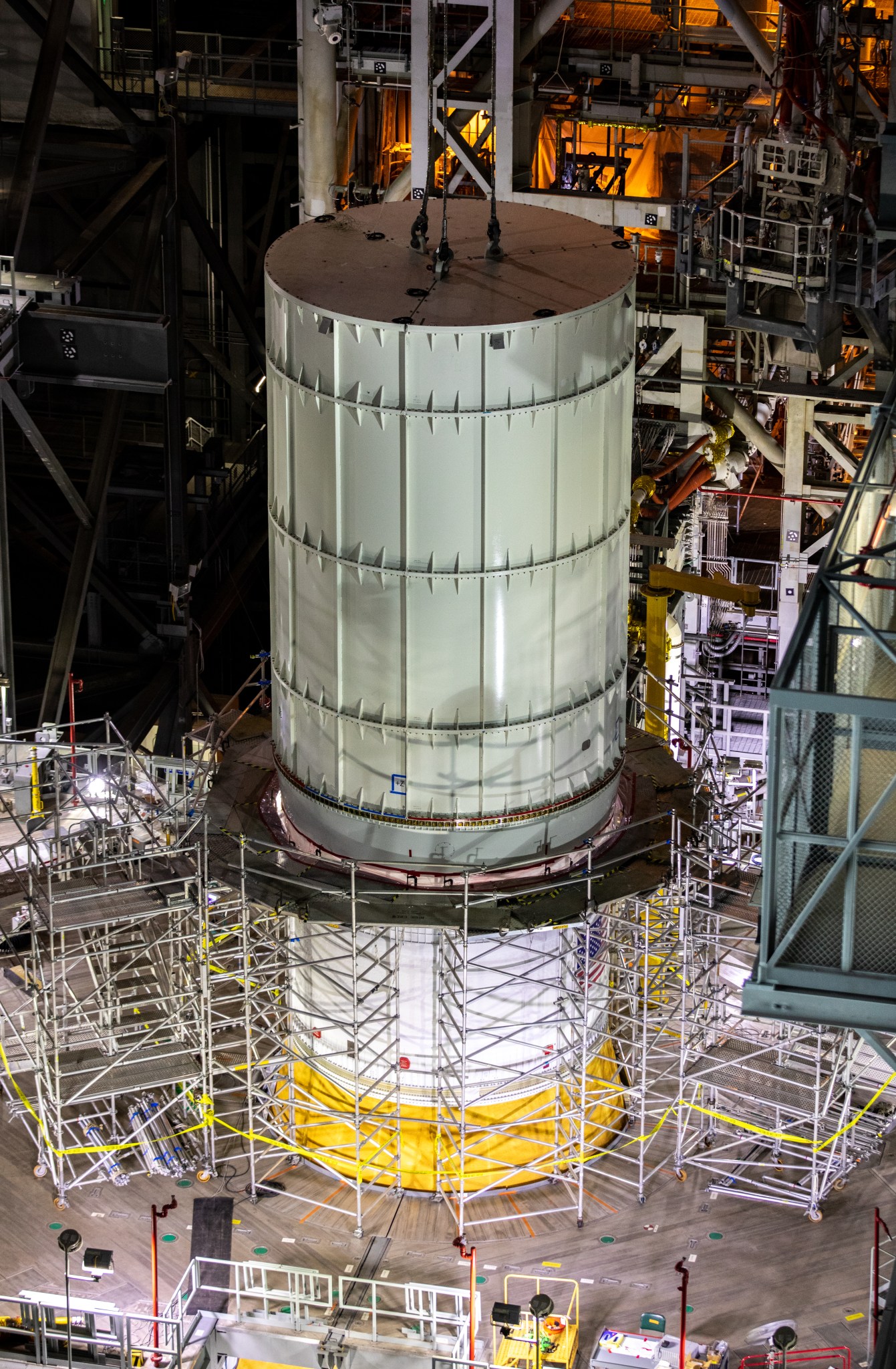
“We will use the modal testing data for multiple purposes,” he said. “We will compare the physical results with what computer models predicted. The information will also be fed into the flight computers so when SLS is flying, the computers know which vibrations are natural to the rocket and which are caused by external forces. The computers will use that information to steer the rocket, ensuring it is placed in the right orbit and does not unnecessarily deplete its fuel by reacting to natural vibrations the rocket should ignore.”
NASA’s Exploration Ground Systems and Jacobs team at Kennedy along with the SLS team from Marshall Space Flight Center will perform the tests on the mobile launcher and SLS stack in the Vehicle Assembly Building with support from personnel at other NASA centers. The assembled rocket comprises the solid rocket boosters, core stage, Interim Cryogenic Propulsion Stage, Orion stage adapter structural test article, and mass simulator for Orion. Engineers are using the mass simulator for Orion and the Orion stage adapter structural test article for the modal test series while the Orion spacecraft undergoes assembly of its launch abort system and CubeSat payloads are loaded into the Orion stage adapter for flight. The test hardware has the same weight characteristics as their respective flight components, which is important for this test.
“Approximately 300 sensors are attached to the rocket and mobile launcher to detect, record, and transmit the information,” said Cliff Lanham, senior vehicle operations manager for Exploration Ground Systems at Kennedy. “Instrumentation is installed both internally and externally to the rocket including the boosters.”
The motion pattern of a system vibrating at its natural frequency is called the normal mode. To identify the SLS’s natural frequencies, the team places hydraulic shakers in seven locations on the rocket. A small hammer will deliver calibrated taps near key parts of the navigation system to understand the dynamics local to those spots. A hammer on a dolly will move to different locations on the mobile launcher to impart further vibrations.
For 10 hours a day, several days in a row, the team will conduct the test program. They will take advantage of the overnight shift in the Vehicle Assembly Building, when activity level is low. This quiet setting helps engineers verify the vibrations detected by the sensors are caused by the tests and not by other activities in the cavernous facility or on nearby roads. Some of the tests involve multiple vibration frequencies at the same time – like a guitar producing multiple notes at once – while other tests focus on a specific frequency. Following each round of tests, engineers will analyze the data and plan any adjustments needed for the next test.
While the official test series will end after the multiday program, the sensors will continue collecting data during rollout of the flight stack to Launch Complex 39B, which will include the flight version of the Orion stage adapter with CubeSat payloads and the Orion spacecraft. Sensors will also collect data during the wet dress rehearsal, a practice run of launch countdown that will include filling the core stage and Interim Cryogenic Propulsion Stage fuel tanks with super-cooled liquid hydrogen and liquid oxygen propellants.
“We will use the data collected from the modal sensors to cross-check, update, and validate the integrated SLS structural dynamic math models, which then provides confirmation and confidence of the vehicle design for guidance, navigation, control, and loads during launch,” said Liliana Villarreal, operations flow manager for Exploration Ground Systems. “Bottom line: This test will help ensure we are ready to fly and safely navigate the atmospheric road to the stars.”
Bryan, a Manufacturing Technical Solutions employee, supports SLS Strategic Communications.
First Piece of Artemis II Rocket Hardware Arrives in Florida
The Interim Cryogenic Propulsion Stage for the second flight of NASA’s Space Launch System rocket arrived in Florida on July 28 for the final phase of production. The stage and its single RL10 engine provide the in-space propulsion needed to send NASA’s Orion spacecraft and its crew on a precise trajectory to the Moon for Artemis II, the first crewed mission of NASA’s Artemis lunar missions. It is the first piece of the rocket for the Artemis II flight to arrive in Florida. Boeing and United Launch Alliance, the contractor team for the stage, shipped the stage from ULA’s facilities in Decatur, Alabama, to its Delta IV Operation Center at Cape Canaveral Space Force Station.
The stage will undergo final processing and checkout before it is transported to NASA’s Kennedy Space Center for launch preparations. With Artemis, NASA will land the first woman and the first person of color on the lunar surface and establish long-term exploration at the Moon in preparation for human missions to Mars. SLS and Orion, along with the commercial human landing system and the Gateway in orbit around the Moon, are NASA’s backbone for deep space exploration. SLS is the only rocket that can send Orion, astronauts, and supplies to the Moon in a single mission. (ULA)
NASA Awards $500,000 in Break the Ice Lunar Challenge
By Taylor Goodwin
Thirteen teams from across the United States have won shares of the $500,000 Break the Ice Lunar Challenge grand prize for their ideas on digging and hauling icy Moon “dirt” – or regolith.
The challenge, which opened in November 2020, incentivized new approaches for excavating resources astronauts will need during long-duration missions on the Moon. Water, one of the most important resources, is trapped in icy regolith at the Moon’s poles, inside permanently dark and cold craters.
“Expanding the pool of ideas for excavating lunar resources safely and responsibly requires new technology development,” said Monsi Roman, Centennial Challenges program manager at NASA’s Marshall Space Flight Center. “The system concepts developed as part of this challenge will enable sustainable lunar surface operations, paving the way for us to convert lunar ice to vital resources and decreasing our supply needs from Earth.”
Redwire Space, headquartered in Jacksonville, Florida, won first place and $125,000 for its proposed two-rover system designed for simplicity and robustness. The company’s Lunar Regolith Excavator would excavate large amounts of icy regolith. A versatile, low-mass transportation rover called Lunar Transporter would be responsible for deploying the excavator and delivering regolith and ice.
Colorado School of Mines in Golden won second place and $75,000 for its proposed Lunar Ice Digging System. The system would include three rovers – excavator, regolith hauler, and water hauler, as well as a communications and navigation system. Both haulers would have robotic arms for assembly, maintenance, and repairs. All three vehicles would be teleoperated from a nearby lunar surface habitat.
Austere Engineering of Littleton, Colorado, won third place and $50,000 for its Grading and Rotating for Water Located in Excavated Regolith system. The system has an estimated mass of around 12 metric tons – slightly heavier than a school bus. It would first establish a local positioning system and map the surface and underground rocks obstructing excavation. The system would then excavate icy regolith with a rotary tiller before extracting and delivering water.
NASA selected 10 additional teams that submitted viable and innovative ideas that could benefit to NASA and the nation soon. Each will receive $25,000. They are:
- AggISRU from Texas A&M University in College Station
- Aurora Robotics from the University of Alaska in Fairbanks
- Lunar Lions from the Columbia University Robotics Club in New York
- OffWorld Robotics in Pasadena, California
- Oshkosh Corporation in Oshkosh, Wisconsin
- Rocket M in Mojave, California
- Space Trajectory from South Dakota State University in Brookings
- Team AA-Star in Redmond, Washington
- Team LIQUID from Altadena, California
- Terra Engineering in Gardena, California
Phase 1 challenged teams to design a system architecture for collecting and moving large amounts of icy regolith and water from a permanently shadowed region near the Moon’s South Pole. Teams had seven months to register and submit a detailed system architecture, an excavation plan, and an animation of the system in operation. Thirty-one teams – including academia, industry, and independent inventors from 17 U.S. states, Canada, Australia, and Sri Lanka – submitted eligible proposals.
NASA convened a panel of experts to evaluate and score each team based on their solution’s potential performance in extreme conditions to determine the winners. Specific performance goals included maximum water delivery, minimum energy use, and lowest-mass equipment.
A future Phase 2 of the challenge may focus on hardware development and demonstration.
The Break the Ice Lunar Challenge is a NASA Centennial Challenge, managed by Marshall and NASA’s Kennedy Space Center. Centennial Challenges are part of the Prizes, Challenges, and Crowdsourcing program within NASA’s Space Technology Mission Directorate. NASA has contracted Ensemble Consultancy to support the management of competitors for this challenge.
For more information about NASA prizes, challenges, and crowdsourcing, visit here.
Goodwin, an LSINC employee, supports Marshall’s Office of Strategic Analysis & Communications.
Take 5 with David Brock
By Daniel Boyette
David Brock isn’t one to back down from a challenge. Brock, who is a small business specialist at NASA’s Marshall Space Flight Center and the agency’s Mentor-Protégé Program manager, was diagnosed at the age of 20 with retinitis pigmentosa, an eye disease that gradually led to the loss of his remaining vision over the following decade.
Brock persevered. He earned a bachelor’s degree in business administration from the University of Alabama in Birmingham in 1983 and started his Marshall career in 1984.
“It would take time to overcome the shock of what I would be facing in the coming years,” Brock said, “but I was determined to work through those challenges despite the many skeptics who believed a person without eyesight could not succeed in life. I refused to buy in to that philosophy, Believing that when one rises each day with a sense of expectancy, sets realistic and obtainable goals, and places the job and others first, it most always results in a positive outcome.”
When asked what advice he would give for someone facing a similar prognosis, Brock said the key is to focus on the future.
“Yes, there was indeed a door closing in my life, a door to more than 30 years of useful eyesight, but with its closing, another door was ever so slowly opening,” he said. “The question was simple: Was I willing to pass through that door to start my new journey, or remain where I was at with no direction to guide me in the years to come? There really was only one choice. I had to step out in faith and start my new journey. The key from that point forward was to not focus on my deteriorating eyesight, rather on the opportunities that lay beyond the open door, and that was exactly what I did. No matter what one may be facing in life, I am living proof that one can still have a dream and that dream come true.”
Question: How do you encourage teamwork, collaboration, and integration, especially in this unprecedented telework environment?
Brock: It’s all about the team and the program. Over the past 20 years, I’ve worked tirelessly to build a strong team to help promote the goals and objectives of the program both internally and externally through several initiatives. In January 2003, we established the first Marshall large business council — the Marshall Prime Contractor Supplier Council – which comprises more than 100 members representing approximately 50 large aerospace companies. In 2009, we assembled the first small business council at Marshall — the Small Business Executive Leadership Team – comprising more than 75 members representing 40 small business prime contractors at Marshall. In 2010, we established a team comprised of high-level managers from each Marshall organization, called small business technical coordinators, who help guide small businesses to potential opportunities within their organizations.
The key to affecting positive growth within the program is to grow and expand the team of support. Each of these groups are significantly involved in the planning, coordination, and execution of the program at a very high level of participation. It’s one of the primary reasons the Marshall Small Business Program has received the Administrator’s Cup for having the best program at NASA six out of the past 12 years.
Question: How are you managing your personal and your team’s work-life balance during the COVID-19 pandemic?
Brock: Again, it revolves around the team. We are a very close-knit group, always there for each other, no matter what the situation. There is a sense of oneness among our team that evolves out of ongoing collaboration. Whether together at our morning tag ups, various meetings scheduled throughout the week, or participating in numerous virtual outreach events, we are each there to support one another. I also encourage the team to take time to spend with family, and time away from work, and know that we are all there together to be encouragers and motivators, always willing to lend a helping hand to each other when in need.
Question: How does your team honor and demonstrate NASA’s commitment to creating a diverse and inclusive environment where team members are valued for their unique contributions?
Brock: Diversity and inclusion is a big focus area in our office. It’s a subject we discuss internally on a daily basis, especially with members of our large and small business councils, and in particular our ongoing collaboration with industry representatives seeking to do business at NASA. This is best understood by the type of businesses we council on a daily basis. Whether the company is woman-owned, minority-owned, Hispanic-owned, etc., we are constantly seeking ways to diversify our portfolio of companies providing support to Marshall through direct contracting or subcontracting to the primes.
A story told of Andrew Carnegie is one that has personally had a positive impact on my life, and speaks to the importance of diversity and inclusion in a very special way. During the early 1900s, it was said that Carnegie had more than 100 millionaires working for him, which was unheard of at that point in history. When asked how he was able to hire this many millionaires, he said, “I didn’t, I developed them within the company.” When asked how he was able to accomplish such a feat, he replied that it was like mining gold. Often one has to remove tons of rock and debris to get to the gold, but the key is not to focus on the rock and debris, rather the gold that lies beneath. It’s all about focus, and truly applies to our work environment today.
Question: What key partnerships are your team pursuing to help NASA build and develop a sustainable presence on the Moon? Help push the boundaries of science, technology, and/or human exploration?
Brock: Our team is constantly seeking ways to engage with industry to help grow and expand our industry base of suppliers who can play a key role in the development efforts associated with key NASA programs. We’ve been able to achieve this objective through in-house telecoms with industry, semi-annual Marshall Small Business Alliance meetings, quarterly joint counseling sessions featuring small business service providers and machine shops/fabricators, annual partnership meetings with minority-serving institutions and historically Black colleges and universities, and attendance at virtual outreach events.
Question: Why do you think your team is successful at staying mission-focused?
Brock: By shifting the focus of the program to more than simply meeting a small business goal, to the important role small businesses can and will play in helping NASA and its primes achieve NASA’s Vision for Space. Many of the large businesses supporting NASA today started out as small businesses, including SpaceX, Blue Origin, Boeing, Lockheed Martin, United Launch Alliance, Sierra Nevada, etc., and how that happened was through direct contracting opportunities and subcontracting to the primes. Yes, it’s much more than simply percentage goals and dollars, it’s about expanding our industry base of small business suppliers, an industry base that can and will make significant contributions to our programs in the future.
Boyette, an LSINC employee and the Marshall Star editor, supports Marshall’s Office of Strategic Analysis & Communications.
Nick Benjamin Certified as Payload Ops Director
Nick Benjamin is the latest payload operations director certified by the Payload and Mission Operations Division at NASA’s Marshall Space Flight Center. Payload operations directors are real-time flight controllers for the International Space Station. They manage and direct the 24/7 operations of scientific payloads aboard the space station from the Payload Operations Integration Center at Marshall. The payload operations director is the single point of authority to the space station flight director at NASA’s Johnson Space Center for all of NASA’s payload operations. (NASA)
NASA is Recruiting for Yearlong Simulated Mars Mission
NASA is seeking applicants for participation as a crew member during the first one-year analog mission in a habitat to simulate life on a distant world, set to begin in Fall 2022. In preparation for the real-life challenges of future missions to Mars, NASA will study how highly motivated individuals respond under the rigor of a long-duration, ground-based simulation. The series of missions – known as Crew Health and Performance Exploration Analog – includes three one-year Mars surface simulations based at NASA’s Johnson Space Center. The analogs will support research to develop methods and technologies to prevent and resolve potential problems on future human spaceflight missions to the Moon and Mars. Each mission will consist of four crew members living and working in a 1,700-square-foot module 3D-printed by ICON, called Mars Dune Alpha. The habitat will simulate the challenges of a mission on Mars, including resource limitations, equipment failure, communication delays, and other environmental stressors. Crew tasks may include simulated spacewalks, scientific research, use of virtual reality and robotic controls, and exchanging communications. Crew selection will follow standard NASA criteria for astronaut candidate applicants. Learn more here. (ICON)
Adapting to Seasons of Change, Challenge
Dear Marshall family,
As we get ready to say goodbye to August and hello to September, it reminds me of how quickly seasons come and go. Summer will soon be over. The high school football season has already begun, and the college football season is upon us. Some of you have just experienced your youngest child going off to college, and the season of having your children at home full-time is over, at least for now. This can be a great example of how our reactions to changing seasons can run the emotional gamut, from excitement to sadness, depending upon our own unique circumstances.
I think it’s safe to say that none of us have been excited about the season of COVID-19. It continues to be a time of much change and many challenges, and for many, a great deal of frustration and/or anxiety. Beyond all that, it has brought additional and unexpected losses and grief to many among our Marshall family. Our hearts and prayers go out to those of you who have lost loved ones over the past 17 months, to COVID-19 or otherwise.
I’d like to call out another aspect of the pandemic that is taking a heavy toll on many, if not most, of us – exhaustion. Some people refer to it as just being worn out, and others as COVID-19 fatigue, but whatever you choose to call it, it is very real. It makes sense that this would be such a common experience given how long we’ve been dealing with the pandemic. Even if it hasn’t always felt like it, we adapted pretty well to all the shortages, the changes in how we do work and school, the limitations on what we’re able to do, and all the rest of it. But all that adapting takes a lot of energy and it is tiring. If you happen to be one of those folks who isn’t worn out from all this, count your blessings. But for those of you who are, please know that you are not alone. This again raises the issue of how important it is for all of us to continue to do what we can to take care of ourselves, physically, emotionally, and spiritually, and to also show a little extra kindness and grace to others. We don’t know when the COVID-19 pandemic will end, but please don’t lose sight of the fact that it is only a season, and we will move beyond it.
I think that this is also an important time to pause and show a little extra recognition and support for our veterans. Recent events in Afghanistan have been very difficult to watch, and for the many members of our military who served and protected that nation for years, it is so much worse. So my message to our veterans, inadequate as it is, is, “Thank you again for your service and the many sacrifices that you and your families have made for this country and on behalf of this country.” And for those who served in Afghanistan, please never lose sight of the fact that your service helped provide the entire Afghan nation with a better life – for an entire generation. A recent email from the Department of Veteran Affairs provides important information and links to support services. A copy of the email can be found at here.
I’ll close with another request to be mindful of your well-being and be deliberate in taking good care of yourself. Be kind and do what you can to stay safe and to help others to be safe, as well. Stay engaged with your loved ones, friends, and colleagues, and be willing to both give and receive support. We are stronger together.
Take care,
Dr. Terry Sterry
Licensed psychologist and Marshall Employee Assistance Program coordinator
For more information, visit the Employee Assistance Program page on Inside Marshall. For more information on NASA’s coronavirus response and teleworking, visit NASAPeople.
This Week in NASA History: AS-202 Launches – Aug. 25, 1966
This week in 1966, AS-202 launched from Cape Canaveral, Florida. The mission was an uncrewed suborbital flight to test the Saturn IB rocket and the Apollo command and service modules. The objectives of the flight were to verify the structural integrity, launch loads, stage separation, and operation of subsystems of the Saturn 1B, and to evaluate the Apollo spacecraft separations, emergency detection system, subsystems, heatshield at high reentry velocity, and mission support facilities. All mission objectives were achieved. Today, NASA’s Marshall Space Flight Center is playing a vital role in the Artemis program by developing the Space Launch System. SLS and the Orion spacecraft, along with the commercial human landing system and the Gateway in orbit around the Moon, are NASA’s backbone for deep space exploration. SLS is the only rocket that can send Orion, astronauts, and supplies to the Moon in a single mission. The NASA History Program is responsible for generating, disseminating, and preserving NASA’s remarkable history and providing a comprehensive understanding of the institutional, cultural, social, political, economic, technological, and scientific aspects of NASA’s activities in aeronautics and space. For more pictures like this one and to connect to NASA’s history, visit the Marshall History Program’s webpage. (NASA)



























